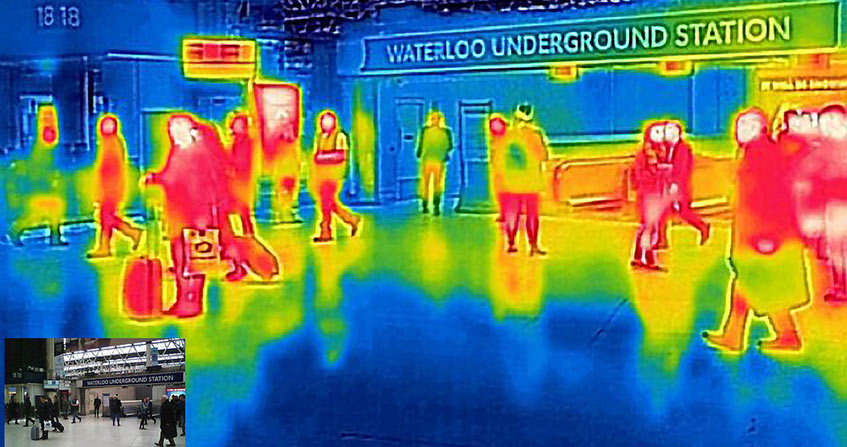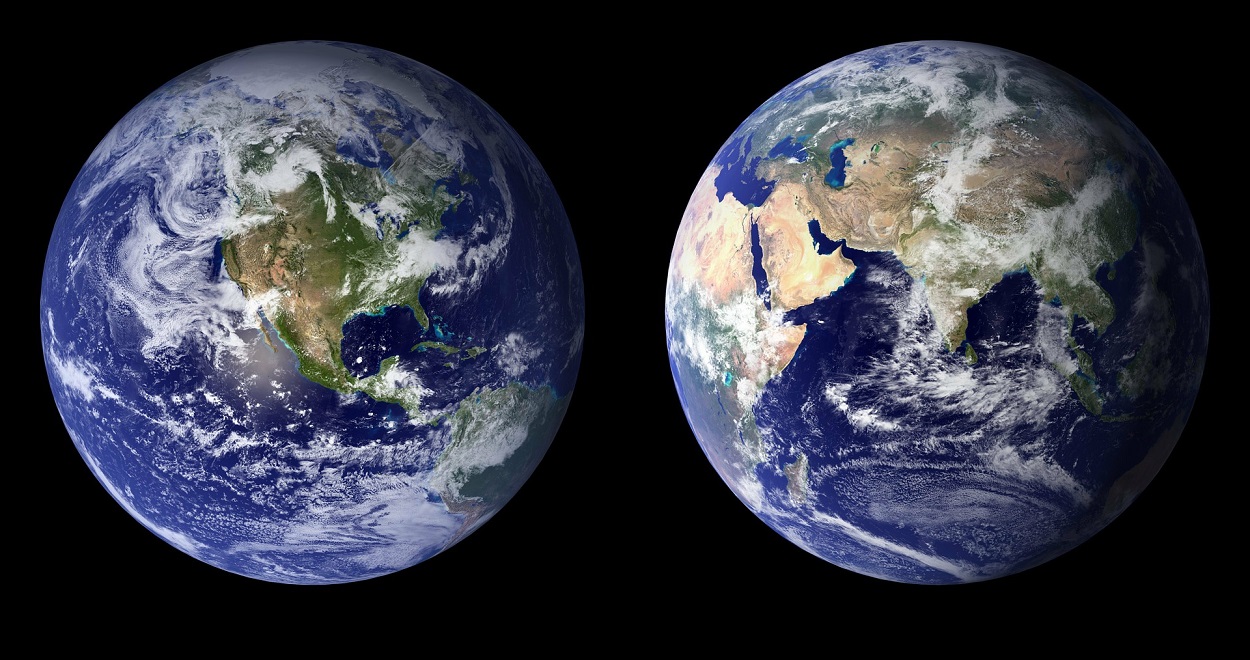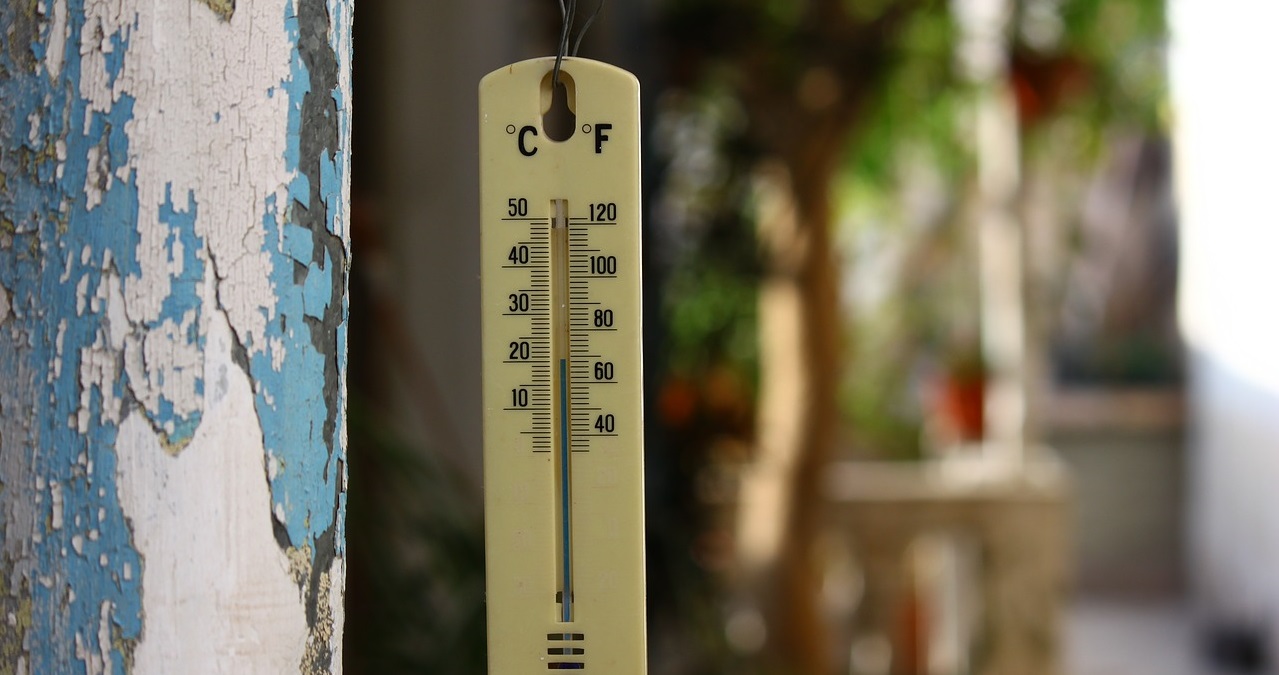Pressure, temperature and heat
PDF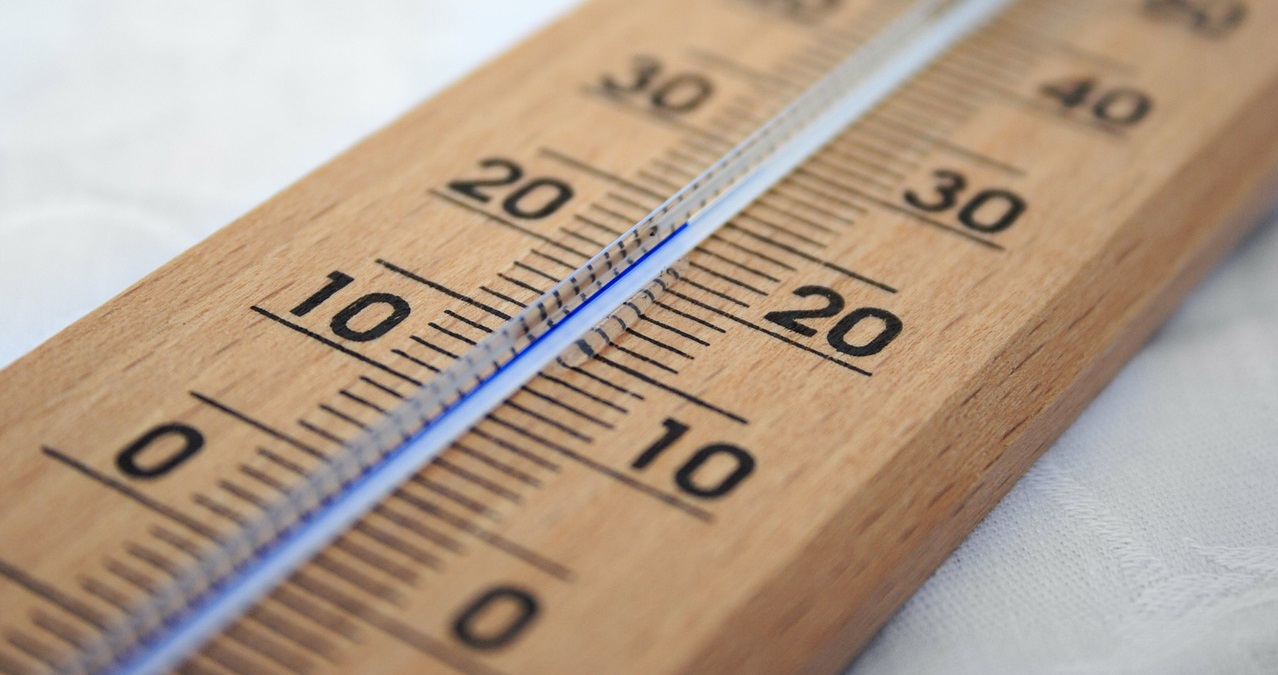
Pressure, temperature and heat are quantities used in everyday life, especially in meteorology. Their physical definition, is however more complex than it seems. It is the result of a long historical evolution. Heat represents the agitation energy of the elementary particles that compose matter: atomic molecules and electrons. In the case of gases, a simple application of the laws of mechanics makes it possible to establish the law of ideal gases relating pressure, volume and temperature. These concepts extend to electromagnetic radiation, which can be considered as a photon gas in equilibrium with matter.
1. Pressure

Historically, the first measurements used a column of mercury in a U-tube, see Figure 1 (left). The tube is initially filled with mercury in an inclined position and then the vacuum appears in A when it is straightened, following the detachment of the mercury. Surface B remains in contact with the atmosphere. The excess pressure is compensated by the weight of the height of mercury, 76 cm on average at sea level. Pressure is obtained as the product of this height of mercury by its density, 13 600 kg/m3, and by the acceleration of gravity 9.8 m s-2. The height of 76 cm thus corresponds to a standard atmospheric pressure of 1.013 x 105 Pa. The international pressure unit is pascal (1 Pa = 1 N/m2), but bar (105 N/m2) and millibar, also called hectopascal (1hPa = 103 N/m2), are often used.
The first mercury barometer of this type was produced by Evarista Toricelli in 1643 to reproduce and explain a phenomenon observed in the fountains of Florence: water could not be sucked up to a height exceeding 10 m, the water column then splitting spontaneously. This height limit is reduced to 76 cm using mercury, 13.6 times more dense. Toricelli attributed this atmospheric pressure to the weight of the air, a concept that was much discussed at the time, as well as the notion of “vacuum”. In 1648, Blaise Pascal provided a crucial verification by showing that this pressure decreases with altitude in his famous experiments at Puy de Dôme. Thus at sea level, our body is compressed by the entire column of air in the atmosphere, equivalent to a column of 10 m of water. During a scuba dive, each meter of descent increases the pressure experienced by the diver. Conversely, any ascent reduces it.

The balance of a fluid column therefore requires that its weight be compensated by the difference in pressure forces at each end (Figure 2a). This reasoning only applies if the top and bottom walls are horizontal. However, the pressure force on a wall is independent of its orientation, as shown by examining the balance of pressure forces on the faces of a corner (Figure 2b). The force is always perpendicular to the wall, as an ordinary fluid such as air or water cannot transmit tangential force in the rest state [1]. If we note p1, p2, p3 the pressures on the three sides of the corner, a projection of the forces on the horizontal and vertical shows that the equality of these three values is necessary for balance. [2]
The considerable pressure on our skin does not affect us, quite the contrary, because an equal and opposite force is exerted inside the lungs [3]. And the vector sum of the pressure forces, far from being a burden, is actually directed upwards. Indeed, it is none other than Archimedes’ thrust, equal to the weight of the air displaced. This force reduces us by about 1/800 of our weight, the ratio of the density of the air to the human body. Any part of a fluid at rest remains in balance between its weight and the Archimedes’ thrust, resulting from the pressure forces acting on its surface.
The pressure is thus defined at any point in the fluid, regardless of the orientation of the surface on which the pressure force is manifested. The pressure induced by the weight of the fluid column is called hydrostatic. In a flow, there is also a so-called dynamic pressure induced by the acceleration of the fluid. This is how a depression appears in the heart of the eddies, resulting in a digging of the free surface in a sink or river, or the suction of the roof of a house in a tornado. This effect can be understood as a balance between pressure force and centrifugal force directed towards the outside of the vortex. At the heart of the vortex, the pressure must be lower than its peripheral value to compensate for this centrifugal force. For large atmospheric eddies, a depression appears at the heart of the cyclones, which rotate in the same direction of rotation as the Earth (Read “Tropical Cyclones: Development and Organization“). The anticyclones, in the opposite direction, are the seat of high pressure due to the Coriolis force (link to be introduced).
2. Temperature
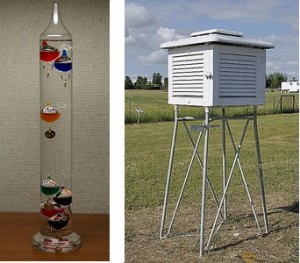
Other phenomena depend on temperature and thus make it possible to detect it. Electronic thermometers generally use the variation of an electrical resistance. They use either a platinum film, chosen for its stability, or a semiconductor thermistor, chosen for its high temperature sensitivity. Liquid crystals allow a direct visualization of the temperature by the variation of their color. Thermocouples are made of two different metal wires welded at both ends: when these two welds are at different temperatures, a difference in electrical potential is produced between them, which allows the temperature difference to be measured.
A fundamental observation is that an environment left at rest and isolated from the outside tends towards a uniform temperature state. This is called thermal equilibrium. We can thus define the equality of the temperatures of two bodies if they remain in the same state of equilibrium after being brought into contact.
The temperature displayed by a thermometer is the temperature of the thermometer itself. It is therefore necessary to ensure that this thermometer is in thermal equilibrium with the medium whose temperature you wish to measure. This is why in meteorology the temperature must be measured under shelter (Figure 2). If radiation heats the thermometer (for example, radiation from the Sun, from the ground or from a wall heated by the Sun), the temperature of the thermometer increases and it is no longer in equilibrium with the atmosphere. Also the thermometer must not be wet because evaporation cools it down.
What we feel and value as a “temperature” is therefore not always an accurate representation of temperature. In a room at a uniform temperature, a metal feels colder to the touch than wood, because it better evacuates heat from our body. Similarly, wind and humidity increase our feeling of cold. Weather reports attempt to describe this effect by the “felt temperature”, but it is an empirical and ambiguous concept not to be confused with temperature. What we feel represents the tendency of our environment to cool down or warm up. It depends on many parameters such as our clothing, the local wind, the humidity of the air, as well as the direct impact of solar radiation on our skin.
3. Heat
Unlike temperature, the amount of heat is proportional to the mass of the heated body and can be exchanged between different bodies. The old unit is the calorie, the amount of heat needed to heat 1 g of water at 1°C. It takes 10 calories to heat 10 g of water at 1°C or 1 g of water at 10°C.
Until the 19th century, heat was considered a fluid called “caloric”. This was supposed to be produced by fire and could then spread to different environments. It was only after James Prescott Joule‘s work in the 1840s that heat was considered a form of energy (see “Energy“). His mechanical device is shown in Figure 4 and he also used experiments using electrical current. As users of electric water heaters, this equivalence between heat and energy is familiar to us, but it was not the same in the 19th century. Heat is now expressed in joules, using the equivalent of 1 calorie = 4.18 joules [5].

The mass heat capacity (per unit mass) of a body, also called specific heat, is the body’s ability to store heat. This is precisely defined as the amount of heat required to raise the temperature of a 1kg mass by 1°C. As we have seen, it is 4.18 kJoules/kg/°C for liquid water (4.18 Joules per 1 g). This is a particularly high value. For a dry ground the thermal mass capacity is approximately 5 times lower.
If we mix 1 kg of water at 50°C with 1 kg of water at 0°C, we obtain two litres at 25°C, following the heat transfer between cold and hot water. The specific heat is ten times lower for a metal such as iron, CFe = 0.1 Ceau. Thus 1 kg of iron at 50°C placed in 1 kg of water at 0°C will balance at a temperature teq such that CFe(50-teq) = Ceau(teq-0), the heat lost by the CFe(50-teq) iron used to heat the water from 0 to teq. This leads to teq = 50*CFe/(CFe+Water) = 4.5°C.
The latent heat of vaporization is the amount of heat required to evaporate a liquid without changing temperature. The heat of vaporization of a litre of water is 2,257 kJ/kg (at atmospheric pressure and 100°C), 5.4 times more than to heat a litre of water from 0 to 100°C. This transformation is reversible, the same heat being released during condensation. This plays an important role in meteorology by promoting the rise of hot air by convection, during a storm or in the middle of a cyclone: condensation limits the cooling of the air by expansion and thus amplifies the excess temperature of the rising fluid compared to its environment. In meteorology, sensible heat is used to express the amount of heat associated with a rise in temperature, as opposed to latent heat associated with the formation of steam. In a tropical cyclone, for example, solar radiation evaporates from the ocean, providing latent heat that is then released as sensible heat when the vapour condenses during the rise of the air.
It is also necessary to provide latent heat of fusion, 333 kJ/kg, to convert the ice into a liquid state. It is about 7 times lower than the latent heat of evaporation, but still equivalent to the heat required to raise the temperature of the liquid water by 80°C. Conversely, solidification releases this latent heat in the form of sensible heat that must be evacuated to allow solidification.
4. The law of perfect gases
In the 18th century, it was experimentally established that sufficiently diluted gases satisfy the perfect gas equation which expresses that the product of pressure p by volume V depends only on temperature. Thus, in a cylinder whose volume is reduced by half by a piston, the pressure is doubled at constant temperature. In addition, it was discovered that this pV product was a linear function of temperature. Extrapolation of this relationship to lower temperatures than the gas state led to a zero value of the product pV at temperature t = -273 °C, identical for all gases. This observation made it possible to define the absolute temperature T = t + 273, then expressed in Kelvin (K), well before being able to approach the temperature T = 0 K, called absolute zero.
The law of perfect gases is then written pV = nRT, where n represents the number of moles of gas and R = 8.31 Joules/mole/K. This formulation expresses Avogadro’s law, which stipulates that under given temperature and pressure conditions, equal volumes of different perfect gases always contain the same number of molecules. This law proposed by Avogadro in 1811 remained ignored or contested for a long time, the very notions of atoms and molecules being very hypothetical at the time. If it is difficult to count atoms, the relative masses of the different atoms can be compared by their chemical combinations. Thus we know that a mass of 16 grams of methane CH4 consists of 12 grams of carbon and 4 grams of hydrogen, which makes it possible to allocate the mass of 12 grams for one mole of carbon and 1 gram for the mole of atomic hydrogen taken as a reference (and therefore 2 grams for the molecule H2). This of course requires knowledge of the chemical formulae, which has been made possible by cross-referencing many chemical reactions. [6]
Since the beginning of the 20th century, we have known how to “count” molecules and therefore estimate the number of Avogadro NA, i.e. the number of molecules contained in a mole. This led to writing the law of perfect gases in the form pV = NkBT, where N is the number of molecules and kB is the Boltzmann constant kB = R/NA= 1.38 × 10-23 J-K-1.
5. Temperature and molecular stirring energy
The pressure of a gas is easily explained by the effect of the shocks of molecules on the walls, which was understood as early as 1738 by the Swiss physicist, mathematician and doctor Daniel Bernoulli. An application of the laws of mechanics, detailed in the focus, thus leads to linking the pressure to the average kinetic energy of the molecules in a direction, pV = m<u2> (the hook <.> representing an average on the molecules). The identification with the law of perfect gases thus makes it possible to interpret the absolute temperature as the energy of agitation of the molecules in a direction, by the formula (1/2)m<u2> = (1/2)kBT, which can also be written (1/2)(NAm)<u2> = (1/2)RT. For air, with an average molecular weight NAm = 29 g, this leads to a molecular velocity [7] of 300 m/s at ordinary temperature T = 300 K. For a pollen grain mass of 10-15 kg (diameter 1 µm), this leads to a stirring rate of 2 mm/s. It is the observation under a microscope of this Brownian motion that allowed one of the first measurements of the Boltzmann constant and therefore of the Avogadro number.
Apart from the historical practice of defining the temperature scale from the properties of water (100 K is the difference between boiling and melting temperature at standard pressure), it is logical to express the temperature in energy units rather than Kelvin (so that kB = 1). This is indeed a common practice in physics.
This theory also makes it possible to calculate the specific heat of a gas. To raise the temperature by 1 K, it is necessary to provide the energy (1/2)kB per molecule for its translation movement in a given direction. Since molecules move in all three dimensions, it is necessary to multiply by 3 to have the total kinetic energy of translation, hence a specific heat [8] (3/2)kB per molecule, or (3/2)R per mole. This is verified for monoatomic gases such as argon or helium, but for molecules it is necessary to take into account the energy of internal rotational movements. These movements contain energy without contributing to the pressure. For molecules with two atoms such as nitrogen and oxygen, the main components of air, it can be shown that these rotational movements have an energy kBT, leading to a specific heat (5/2)R.
The link between temperature and molecular stirring energy is more complex in a liquid or solid. Molecules or atoms are held in compact stacks by molecular attraction forces. It is to overcome these forces of attraction that the latent heat of evaporation is used. Fusion also requires a supply of energy to move from the periodic scheduling that characterizes the solid to the disordered stacking of the liquid. These effects are reversible, with latent heat being released as sensible heat during reverse condensation and solidification processes.
The law of perfect gases makes it possible to measure a temperature from the pressure of a gas. This is the principle of gas thermometers used as a reference for calibrating thermometers for more common use. However, from a theoretical point of view, physicists prefer to use a more fundamental definition that applies directly to any medium without reference to a gas. In addition, at very low temperatures all bodies condense and no more gases are available. This leads to the definition of the temperature of a medium based on the notion of entropy (link to the article Thermodynamics). This temperature coincides with that obtained by the law of perfect gases when such a gas exists.
6. Heat transfers
Any isolated environment tends towards a state of thermal equilibrium [9] characterized by a uniform temperature. This is achieved by transferring heat from hot areas to colder areas in three distinct types of processes.
Conduction, also called thermal diffusion, is the transmission of thermal energy by the disordered movements of the constituents of matter: shocks between molecules for gases, vibrations in solids, transport of electrons in metals. Conduction is effective on a small scale, and we observe for example that a hot object of a few centimetres cools down in a few minutes. This diffusion time depends on the thermal conductivity of the material, but it also increases as the square of the dimension, thus becoming 10,000 times longer for an object 100 times larger. It takes several months at atmospheric temperature to diffuse into the ground beyond a few metres. This is why the subsoil temperature remains constant throughout the year. If the annual average is less than 0°C, the ground remains permanently frozen, it is the permafrost (see “The permafrost“).
In a fluid, convection is often the dominant mechanism for heat transfer. It is the moving material that transports the heat it contains. The diffusion is then limited to the transfer of heat between the walls and the fluid in a thin contact zone called the thermal boundary layer. Convection is said to be forced when the flow is mechanically produced, for example in a pump-driven cooling system. Natural convection corresponds to the movement of the fluid by density variations due to the thermal effects themselves. This is what stirs the water in a heated pan, or raises the hot air above a radiator. The moving atmosphere is a vast system of natural convection.
7. Thermal radiation
Radiation is a third type of heat transfer. This is how we receive the heat from the Sun. Light is usually emitted by an atom during a transition of an electron from an excited energy level to a lower level. This emission is made at the frequency ν related to the energy difference E between levels by the famous relationship of E = hν, where h = 6.6 × 10-34 m2 kg/s is the Planck constant. Radiation consists of photons of energy E. In a laser or fluorescent tube lamp, the light comes from a single transition or a limited number of transitions, defining emission lines.
In the Sun, photons scatter long distances within the gas before being emitted into space, which randomly modifies their frequency, and therefore their energy, by Doppler effect. They thus acquire an energy distribution in thermal equilibrium with the material. This radiation can be considered as a photon gas, which can also be observed in a cavity, for example a furnace, whose walls emit and permanently absorb radiation.
Unlike molecules of a conventional gas, photons always move at the speed of light c. On the other hand, by analogy with a molecule gas, the average energy of the photons hν is expected to be proportional to kBT. This can also be expressed in wavelength λ=c/ν (distance travelled in a period 1/ν), which gives hc/λ~kBT, or λT~hc/kB. This estimate is in accordance with Wien’s law which more precisely expresses the wavelength λm of the maximum spectral density : λmT = 0.201 hc/kB = 2.896 10-3 mK (see link to radiation article). For the Sun, whose emitting surface is at a temperature of T = 5700 K, this wavelength is λm = 0.5 µm (yellow light), while for an electric radiator at T = 570 K (297 °C), it is equal to 5 µm, located in the infrared.
This radiation in thermal equilibrium at temperature T has a wavelength distribution around this maximum λm. This corresponds to what is called the Planck spectrum or blackbody radiation spectrum. A black body is defined as a body that absorbs all the radiation it receives. If such a body is placed in a cavity at temperature T it must re-emit all the energy it absorbs to remain in thermal equilibrium with its environment, showing that the total radiated power per unit area is proportional to T4.
Any body emits thermal radiation that is more or less similar to that of the black body. If now the body only absorbs a proportion η of the radiation received it must also emit a proportion η of that of a black body. Otherwise it would spontaneously cool down if it were placed in a cavity at temperature T: in equilibrium it must emit as much energy as it absorbs. This rule, called Kirchoff’s law, must apply to any temperature, and therefore to any wavelength (see the article on thermal radiation). It should be noted that the emission lines of a laser or fluorescent lamp exceed the thermal radiation at the wavelengths concerned, but this is electrical, not thermal excitation. Inversely, absorption lines are observed in the solar spectrum, as well as in the infrared spectrum emitted by the Earth (link article radiation and climate). This is due to the absorption during the passage of atmospheric layers colder than the emission zone.
References and notes
[1] However, a tangential force, called shear force, is produced by a flow along the wall.
[2] This implies neglecting the weight of the air contained in the area, which is justified regardless of the density of the fluid within the limit of a small length a (indeed the weight is proportional to a2 and therefore becomes negligible compared to the pressure forces proportional to a).
[3] During a scuba dive, it is imperative never to block your breathing to avoid disrupting this balance between internal and external pressure.
[4] Originally, in 1742, Celsius used a scale from 100 to 0, then inverted into the current form.
[5] Note that the calorie, still used to express the energy provided by food, is actually a kilocalorie, equal to 4.19 kJoules.
[6] Avogadro’s law itself is also used to constrain chemical formulas. Thus, to validate its law, Avogadro had to assume that gases such as oxygen or nitrogen are made up of diatomic molecules rather than isolated atoms, which at the time seemed an ad-hoc hypothesis without foundation.
[7] It can be generally shown that in a gas the speed of the molecules is close to that of sound propagation.
[8] More precisely, it is the specific heat CV at constant volume. When a gas is heated to constant pressure, it expands and thus cools by expansion. Additional thermal energy must then be supplied, which leads to the specific heat at constant pressure CP = CV + R per mole.
[9] More generally, we speak of thermodynamic equilibrium including the mechanical balance of pressures and that of possible chemical reactions.
The Encyclopedia of the Environment by the Association des Encyclopédies de l'Environnement et de l'Énergie (www.a3e.fr), contractually linked to the University of Grenoble Alpes and Grenoble INP, and sponsored by the French Academy of Sciences.
To cite this article: SOMMERIA Joël (February 5, 2019), Pressure, temperature and heat, Encyclopedia of the Environment, Accessed January 21, 2025 [online ISSN 2555-0950] url : https://www.encyclopedie-environnement.org/en/physics/pressure-temperature-and-heat/.
The articles in the Encyclopedia of the Environment are made available under the terms of the Creative Commons BY-NC-SA license, which authorizes reproduction subject to: citing the source, not making commercial use of them, sharing identical initial conditions, reproducing at each reuse or distribution the mention of this Creative Commons BY-NC-SA license.





